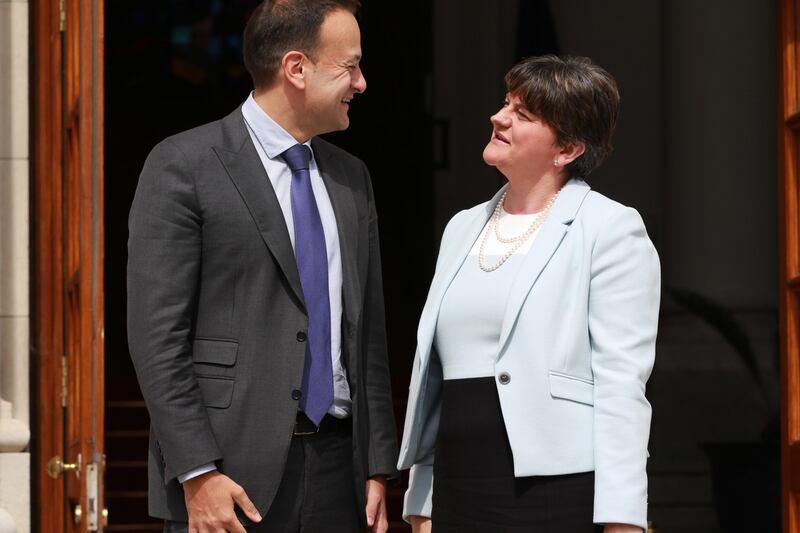When Tony Blair and Bertie Ahern signed the Belfast Agreement in 1998, it had only been a year since a British government had last needed unionist MPs for a Commons majority. So the prospect of that happening again would have been fresh in everyone’s mind. Not many would have anticipated the DUP completely supplanting the UUP at Westminster, let alone this coinciding with Brexit. But the asymmetrical complication of one side in Northern Ireland propping up one sovereign guarantor of the peace process was entirely foreseeable.
What made this acceptable is that unionist importance in London is only ever a passing fluke, occurring roughly once a generation as a government falls apart.
None of this applies to Sinn Féin’s role in Dublin.
In 1998, the republican party had one TD and 2 per cent of the vote. Joining an Irish government seemed too distant a prospect to affect the agreement – and even Sinn Féin thought so. The peace process was sold to republicans on a projection that the 2001 census would show an imminent Catholic majority in Northern Ireland, triggering a short sequence of Border polls and Irish unification by 2016 – a target date often mocked but which made more sense 20 years ago than realised.
When the election proved another disappointment, reality set in and the party redoubled its efforts at growth and consolidation
Only when the census proved a disappointment did Sinn Féin shift to a new sales pitch, claiming unification would be under way once the party was in office north and south.
There were plausible hopes for this ahead of the 2007 Irish general election. Sinn Féin reportedly planned to seek the education portfolios in Belfast and Dublin and appoint one minister over both.
Same goal
When the election proved another disappointment, reality set in and the party redoubled its efforts at growth and consolidation, epitomised by Gerry Adams moving south in 2010. But the goal appeared the same: getting into office north and south, by the Easter Rising centenary if possible, as shown by occasional mad gambles like running Martin McGuinness for the Áras or paralysing Stormont over welfare reform before the 2016 Dáil election.
Ten years on, Sinn Féin’s entry into government has become one of those things that was once expected shortly, so now feels ages away because it was delayed slightly.
A delay is all it is, however, and once the inevitable happens it will be a watershed. The lack of reflection on this verges on denial.
Sinn Féin is the most popular party in the Republic among the under-35s.
It has already bent the old Fine Gael and Fianna Fáil order out of shape, creating what is in effect a grand coalition against it.
Yet Dublin politics seems to proceed as if this is a passing fluke.
June’s DUP-Tory deal at Westminster raised the question of British impartiality in administering the North, as required by the agreement.
Yet it barely raised the question of what will happen if the shoe is on the other foot. The agreement envisages unification as Northern Ireland remaining unaltered, with London and Dublin simply swapping roles – and Dublin inheriting the responsibility for impartial administration.
Recent statements from the Irish Government and Fianna Fáil have echoed this view.
Unionist crutch
London’s occasional need for a unionist crutch may not violate the sovereign impartiality requirement but is the same true of a perennial Sinn Féin presence in office in Dublin? Perhaps that question will determine the agreement’s post-unity lifespan.
In the meantime, aspiring to government has made Sinn Féin the Republic’s main opposition – a significant and durable phenomenon on which the agreement is utterly silent.
Enda Kenny and Charlie Flanagan, as Taoiseach and minister for foreign affairs, stuck to the formal compartmentalisation of the peace process, treating Northern Ireland as a diplomatic issue despite confronting Sinn Féin in Leinster House.
Leo Varadkar has all but abandoned this approach and Simon Coveney seems to be following suit. Sinn Féin is their opposition, north and south.
For unionists, the principle of my enemy's enemy is my friend means Fine Gael and Fianna Fail appear better as their relationship with Sinn Féin gets worse
They do not appear to realise how much of a flipside applies – for many of Sinn Féin’s northern supporters, the Irish Government is now the opposition.
Cross-Border aspects of the latest Stormont crisis should be seen in this light. The SDLP and Sinn Féin are both demanding Dublin intervention, even repeating each other’s soundbites on the subject. But what the SDLP wants is a bulwark against Sinn Féin, while Sinn Féin’s goal is to embroil and embarrass its Dublin rivals. The pan-nationalist front is stabbing itself in the back, yet real all-Ireland party politics has finally arrived – a huge advance for nationalism overall.
For unionists, the principle of my enemy’s enemy is my friend means Fine Gael and Fianna Fail appear better as their relationship with Sinn Féin gets worse. This could drive an all-Ireland dynamic of its own.
It would be wrong to suggest Sinn Féin’s southern rise has breached the agreement, either deliberately or accidentally. But it is bringing forward its sell-by date in unexpected and oddly under-examined ways.












